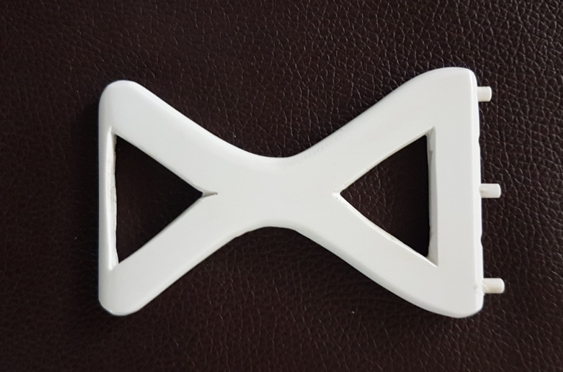- Visibility 67 Views
- Downloads 8 Downloads
- DOI 10.18231/j.ijced.2021.035
-
CrossMark
- Citation
Skin writometer: A novel instrument for assessing provocation threshold in patients with symptomatic dermographism
- Author Details:
-
Kiran Godse *
-
Gauri Godse
-
Anant Patil
Introduction
Physical urticaria is a diverse group of determinable conditions in which patients suffer from a chronic predisposition to develop localized or generalized urticaria upon contact with physical stimuli. Mechanical, thermal or electromagnetic stimuli can produce these responses. It accounts for nearly 20% to 30% of cases of chronic urticaria.[1]
Dermatographism can be simple or symptomatic.[2] Simple dermatographism, a natural physiological response to physical stimuli is reported in about 1.5-5% healthy people.[1], [2] On the other hand, symptomatic dermographism, can result in symptoms such as itching and burning due to wheal and flare response after slight pressure.[1], [2] Symptomatic dermographism can impair the quality of life.[3], [4] The severity of symptomatic dermographism differs among individuals.[3]
Current method for diagnosis of dermographism and its limitation
Conventionally, the diagnosis is made by stroking the skin with a wooden tongue blade [2] or a ballpoint pen with an empty refill.1 Use of ballpoint pen with empty refill is associated with some limitations in clinical practice. The length of the tip of ballpoint pen is fixed. Hence, the intensity of the stroke produced can be variable. Moreover, with traditional single stroke, there is chance of missing the diagnosis.[1] Estimation of provocation threshold i.e. the lowest level of shear force required to produce a positive wheal response is difficult with instruments with single tips/arms. The other methods to diagnose symptomatic dermographism include Dermographic tester, a spring-loaded dermographometer and Fric Test.[3] Dermographic tester also has only one tip[5] whereas Fric Test dermographometer is not available in India.[6]
Considering the limitation of current method, a user friendly, simple but inexpensive method of eliciting dermographism is required.
Skin writometer
We propose a novel instrument, known as the skin writometer for eliciting dermographism. This can be used for diagnosis as well as evaluation of treatment response to dermographism/symptomatic urticaria.
This plastic instrument has 3 smooth arms of varying lengths i.e. 2.5 mm, 3.0 and 4 mms placed 2 cm apart. These arms can be used to strike on the skin in patients of urticaria. [[Figure 1]]

Proposed use
Hold the Skin writometer perpendicular to the forearm
Apply pressure to the Skin writometer so that the tips are almost invisible
Apply a single firm stroke of ~10 cm
Taking the reading after 10 minutes
Precautions while using Skin writometer
Skin at the test site should be unbroken
Skin at the test site should be free of any obvious signs of infection.
Interpretation of the response
Development of wheal with pruritus at the site of largest test arm can be considered as a positive response.
A positive response with all the three arms including the shortest exerting lowest stroke stimulus can be considered as severe dermographism.
A wheal with only the longest arm can be considered as a positive response, but of mild grade.
|
Grade |
Response after skin stroke of ~10 cm length after 10 minutes |
|
Mild dermographism |
Wheal and prutitus with only longest arm of Skin Writometer |
|
Moderate dermographism |
Wheal and pruritus with longest and middle arm or Skin Writometer |
|
Severe dermographism |
Wheal and pruritus with with all the three arms of the Skin Writometer |
Skin writometer has been suggested by others as an alternative option to Fric Test. [7] Although found useful in clinical practice, a formal evaluation through a clinical study is needed to assess its usefulness compared ballpoint pen test.
The suggested approach for conducting clinical investigation may include giving a firm stroke of ~10 cm with the help of a ballpoint pen on one arm and same stroke with Skin writometer on the other arm. The extent of wheals can be measured on both the sides after 10 minutes. The sensitivity and specificity of Skin writometer in identification and diagnosis of symptomatic dermographism can be compared. Similar approach can be used for comparison with the Fric Test.
Conclusion
Skin writometer, may be used as a simple, user friendly and inexpensive instrument for accurate diagnosis of symptomatic dermographism.
Source of Funding
No financial support was received for the work within this manuscript.
Conflicts of Interest
There are no conflicts of interest.
References
- KiranV Godse. Use of a ballpoint pen in the diagnosis of physical urticaria. Indian J Dermatol 2011. [Google Scholar] [Crossref]
- O Taskapan, Y Harmanyeri. Evaluation of patients with symptomatic dermographism. J Eur Acad Dermatol Venereol 2006. [Google Scholar] [Crossref]
- N Schoepke, A Młynek, K Weller, MK Church, M Maurer. Symptomatic dermographism: an inadequately described disease. J Eur Acad Dermatol Venereol 2015. [Google Scholar] [Crossref]
- J Wallengren, A Isaksson. Urticarial Dermographism: Clinical Features and Response to Psychosocial Stress. Acta Derm Venereol 2007. [Google Scholar] [Crossref]
- A. Mlynek, R Vieira dos Santos, E Ardelean, K Weller, M Magerl, MK Church. A novel, simple, validated and reproducible instrument for assessing provocation threshold levels in patients with symptomatic dermographism. Clin Exp Dermatol 2013. [Google Scholar] [Crossref]
- K Godse, A Mehta, S Agarwal, S Patil. Feasibility and utility of the fric test in symptomatic dermographism: A pilot study. Indian J Dermatol 2015. [Google Scholar] [Crossref]
- G Gandhi, R Vasani. White dermographism. Indian J Paediatr Dermatol 2018. [Google Scholar]
